Modeling the Liquid Water Transport in the Gas Diffusion Layer for Polymer Electrolyte Membrane Fuel Cells Using a Water Path Network
Abstract
:1. Introduction
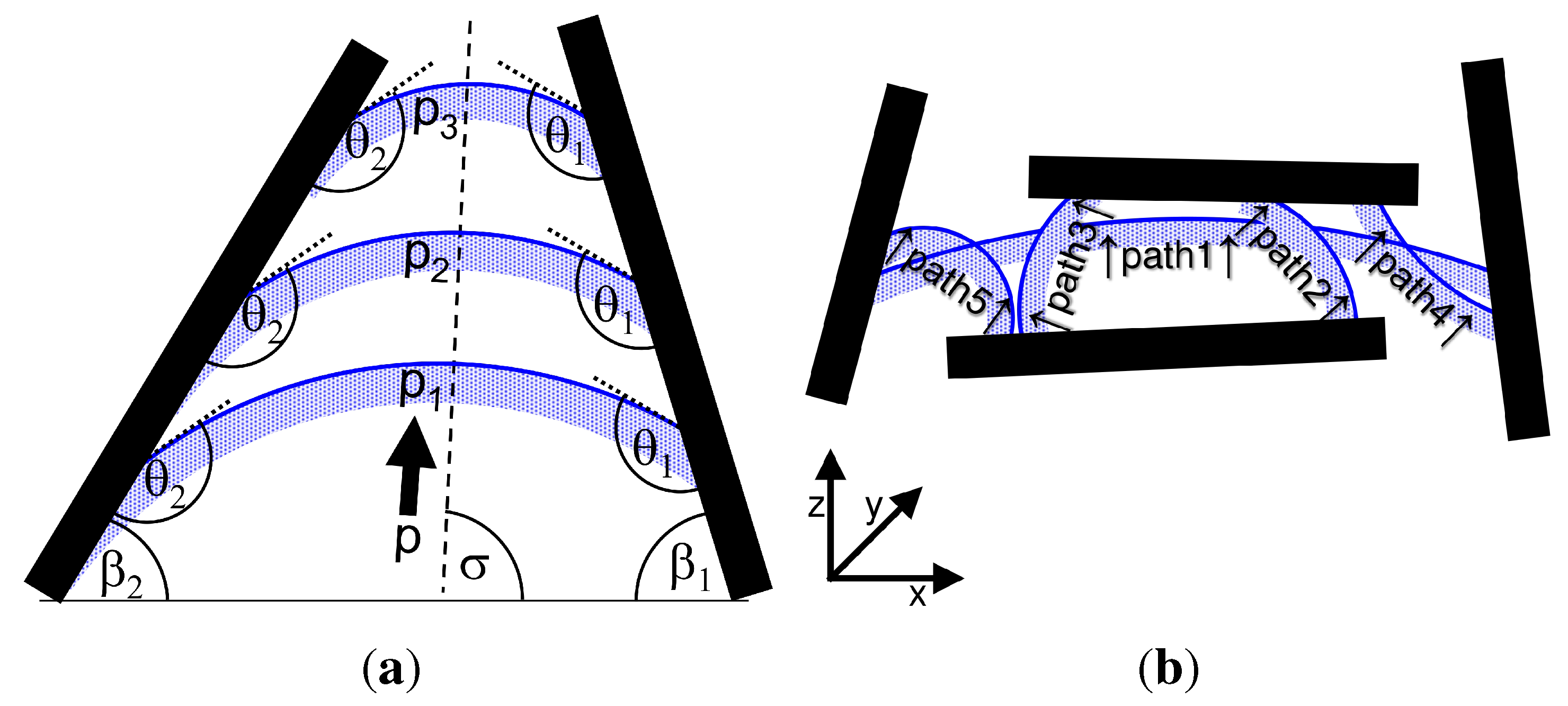
2. Model Description
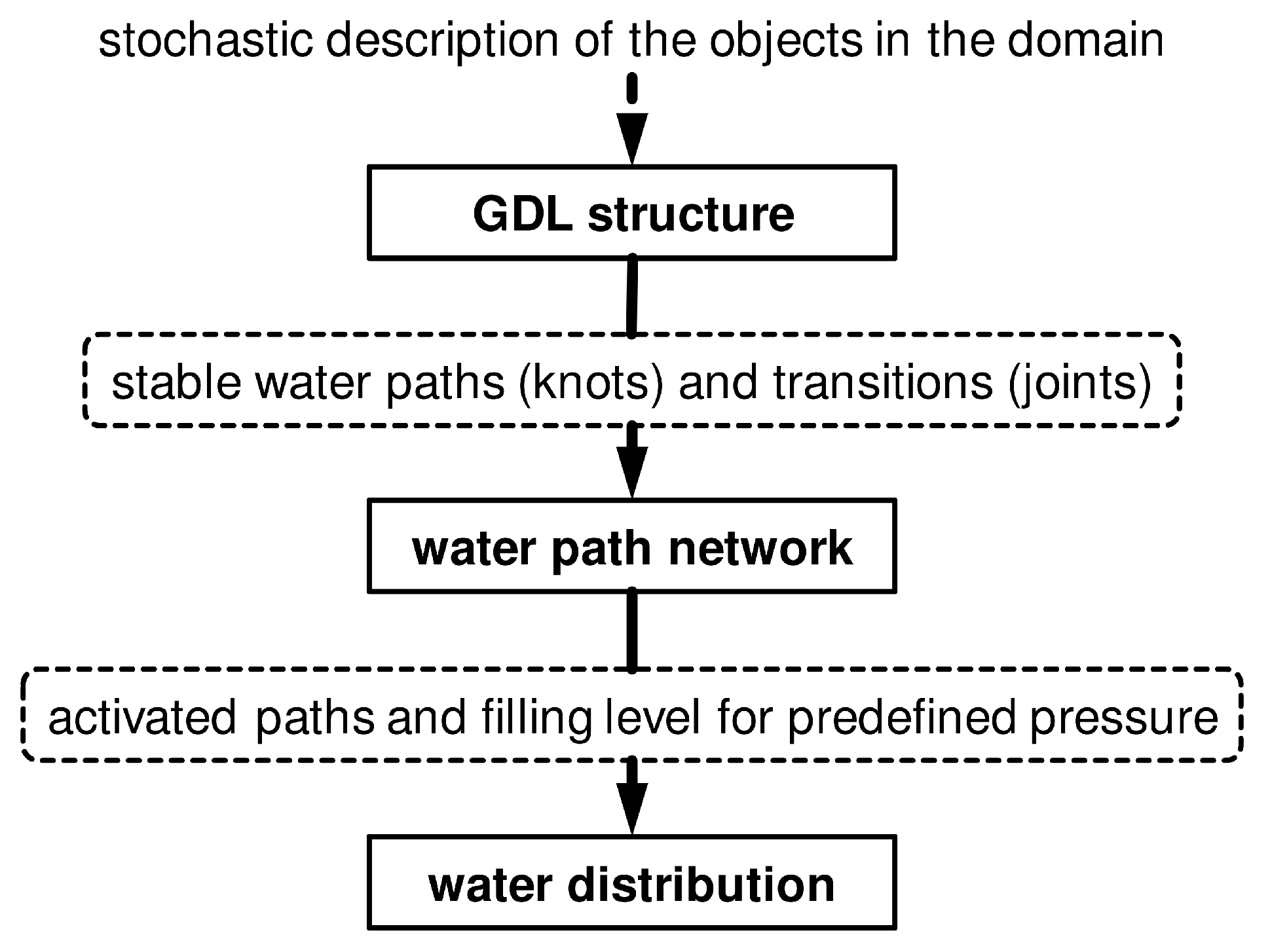
2.1. GDL Structure Generation
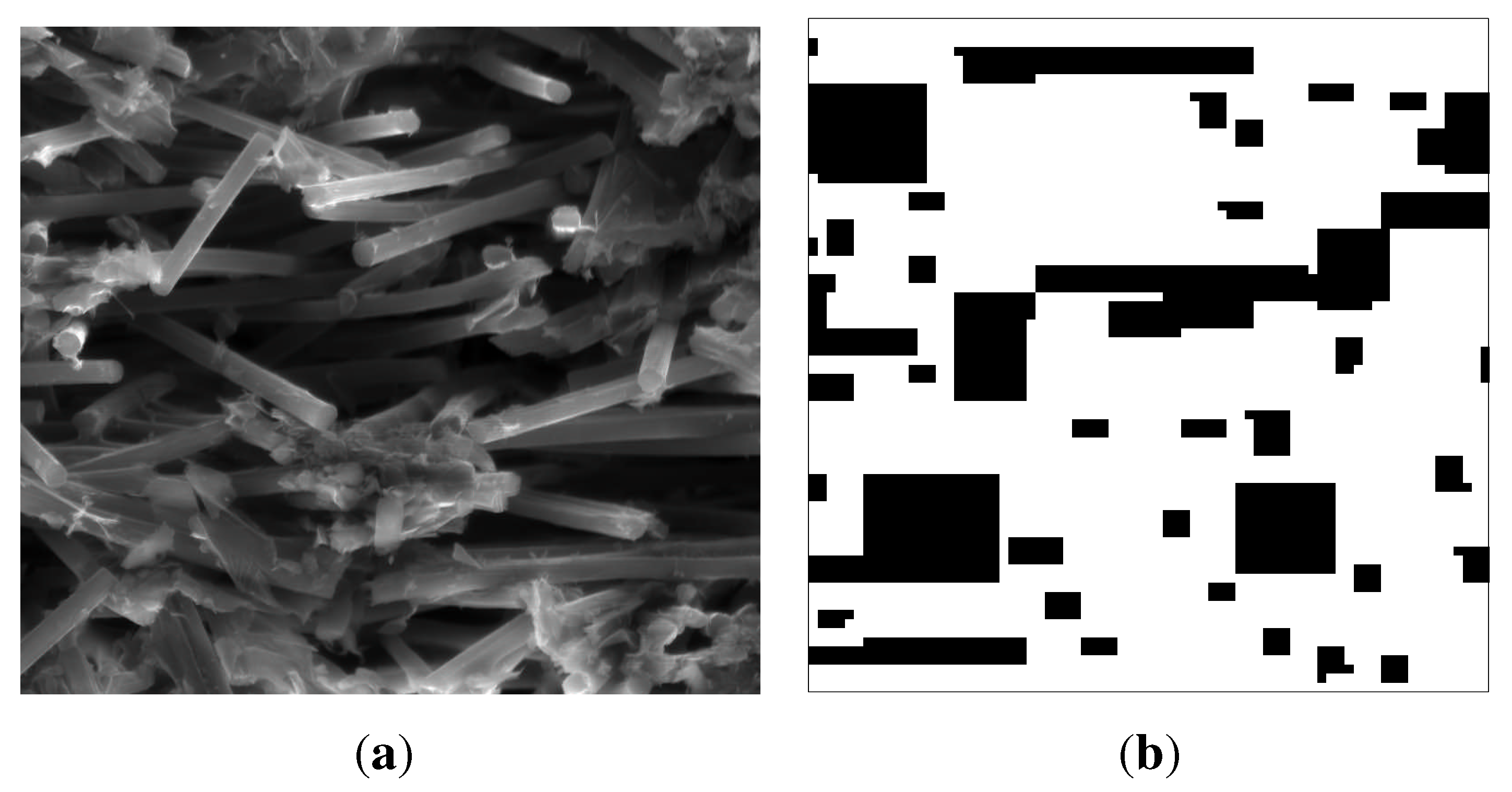
2.2. Network Generation
2.2.1. Stable Water Paths
2.2.2. Unstable Menisci Transition
- the touching point of the object pair is reached;
- a third object interrupts the meniscus in the path;
- one of the contact points outruns the object.

2.3. Liquid Water Percolation
2.4. Phase Change
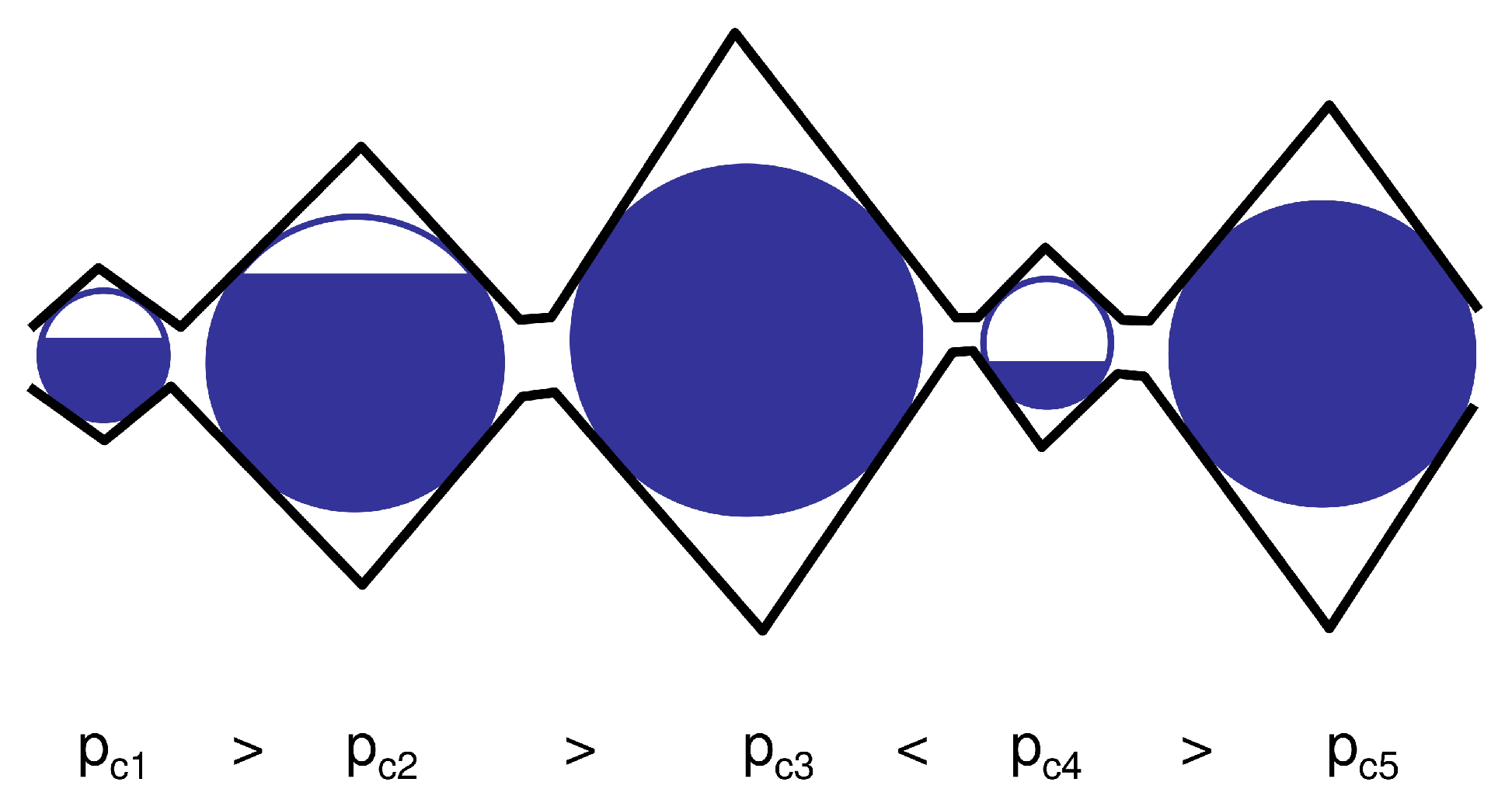
3. Results and Discussion
3.1. Saturation Distribution
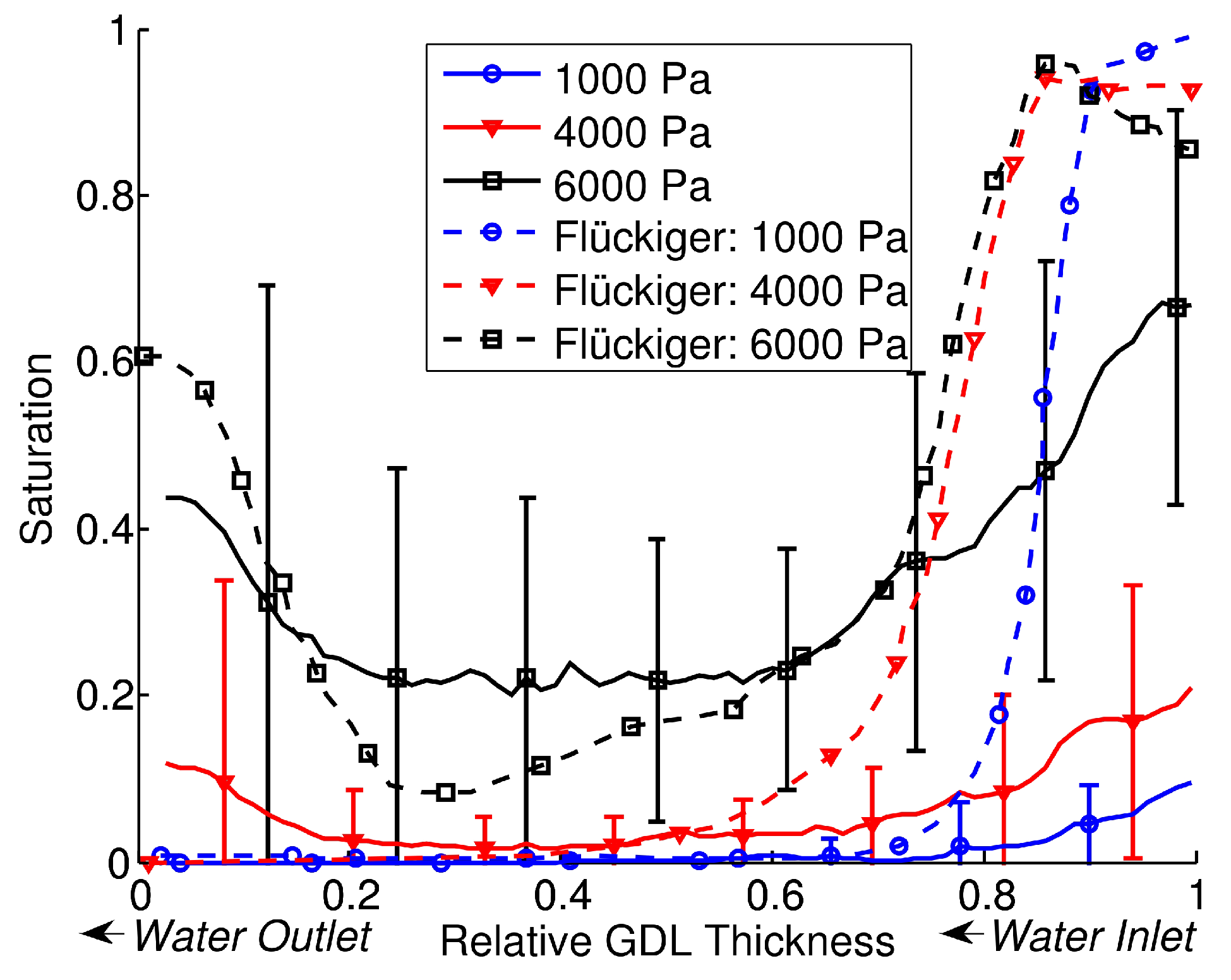
| Material | Domain size/ | Porosity | |||||||
|---|---|---|---|---|---|---|---|---|---|
| μ | σ | μ | σ | μ | σ | h | w | ||
| Toray TGP-H-060 | 9[17] | 2 | 0 | 2 | 220[37] | 1000 | - | ||
| Toray TGP-H-120 | 9[17] | 2 | 0 | 2 | 380[37] | 1000 | - | ||
| Toray 0 wt% | - | - | - | - | 97[38] | 20 | - | - | 0.78[38] |
| Toray 10 wt% | - | - | - | - | 107[38] | 20 | - | - | 0.76[38] |
| Toray 20 wt% | - | - | - | - | 109[38] | 20 | - | - | 0.73[38] |
3.2. Capillary Pressure-Saturation
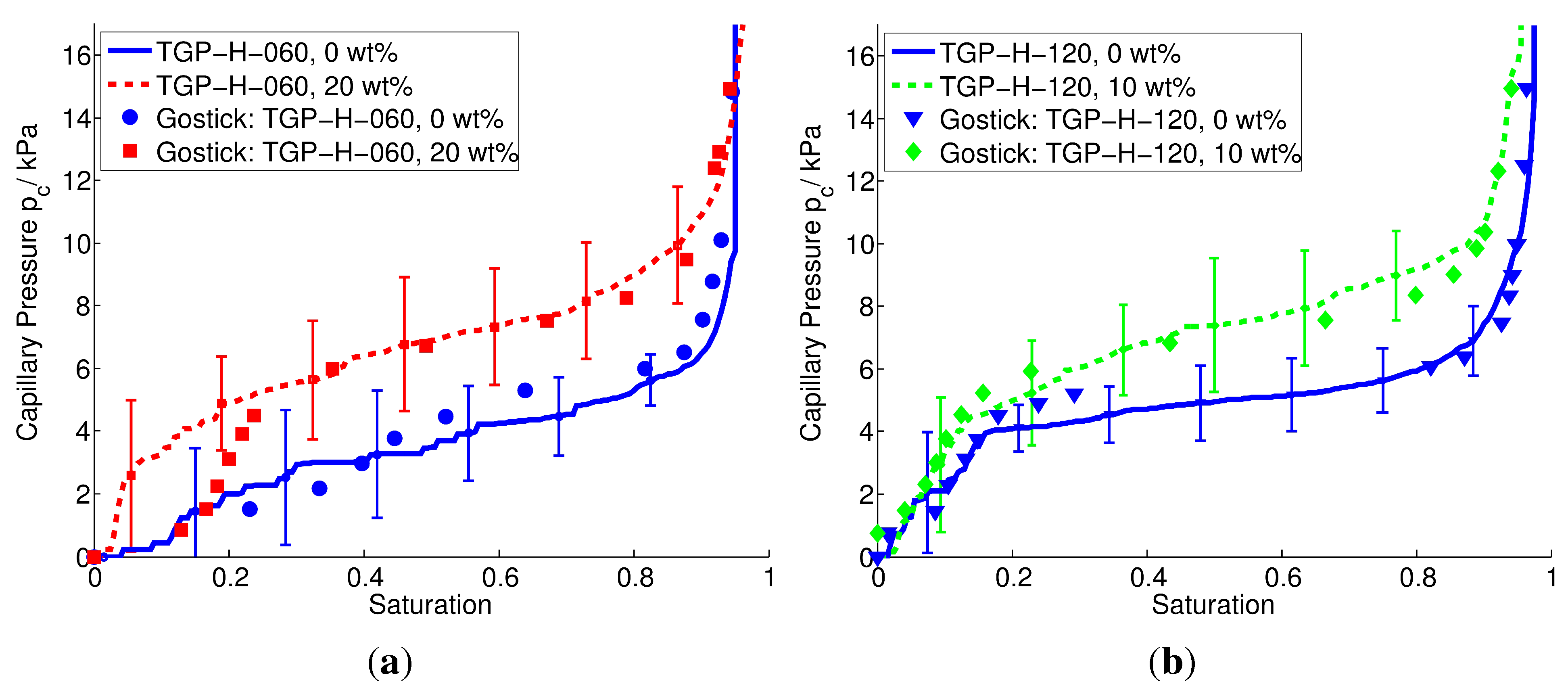

3.3. Oxygen Diffusivity
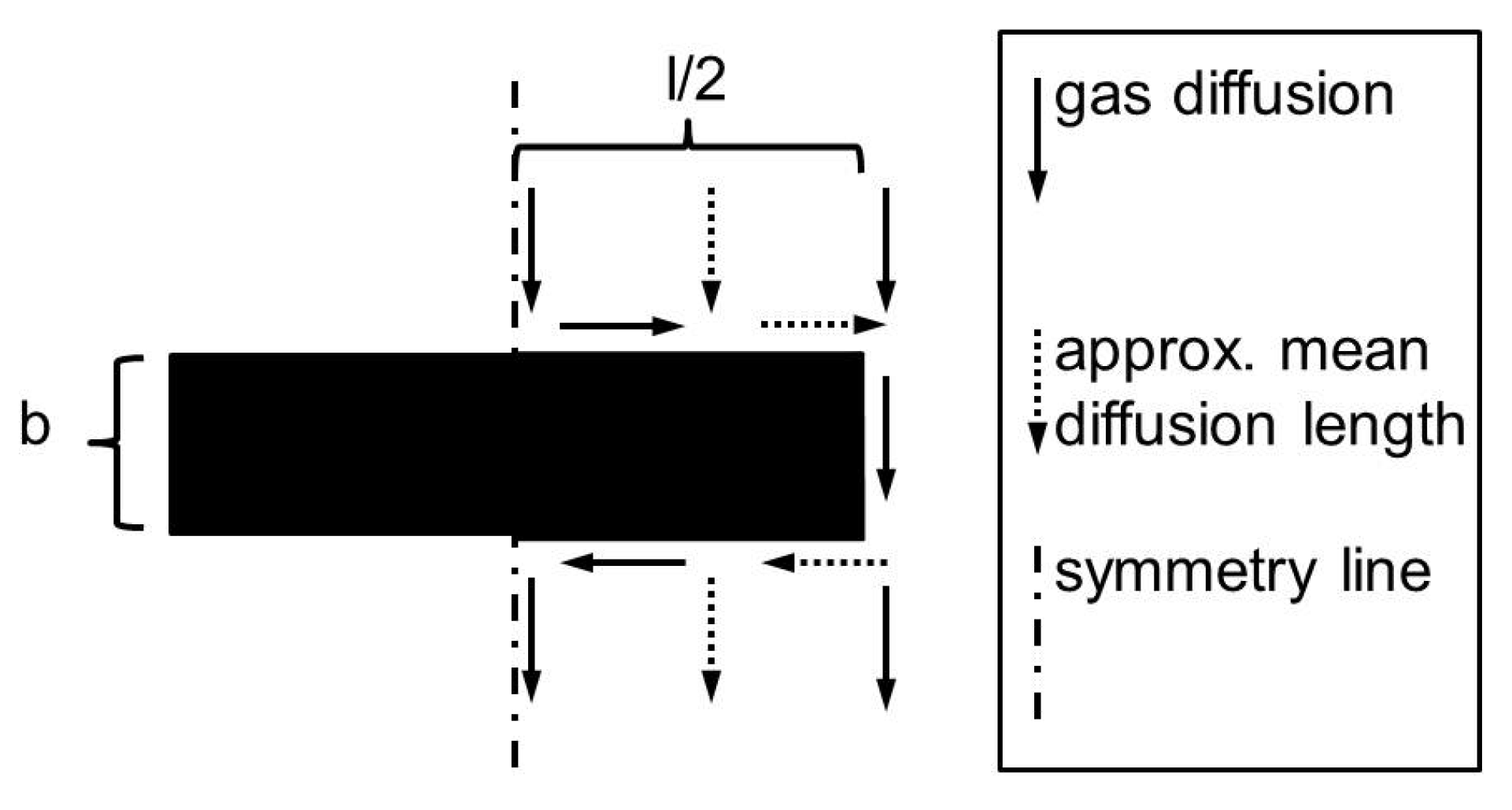
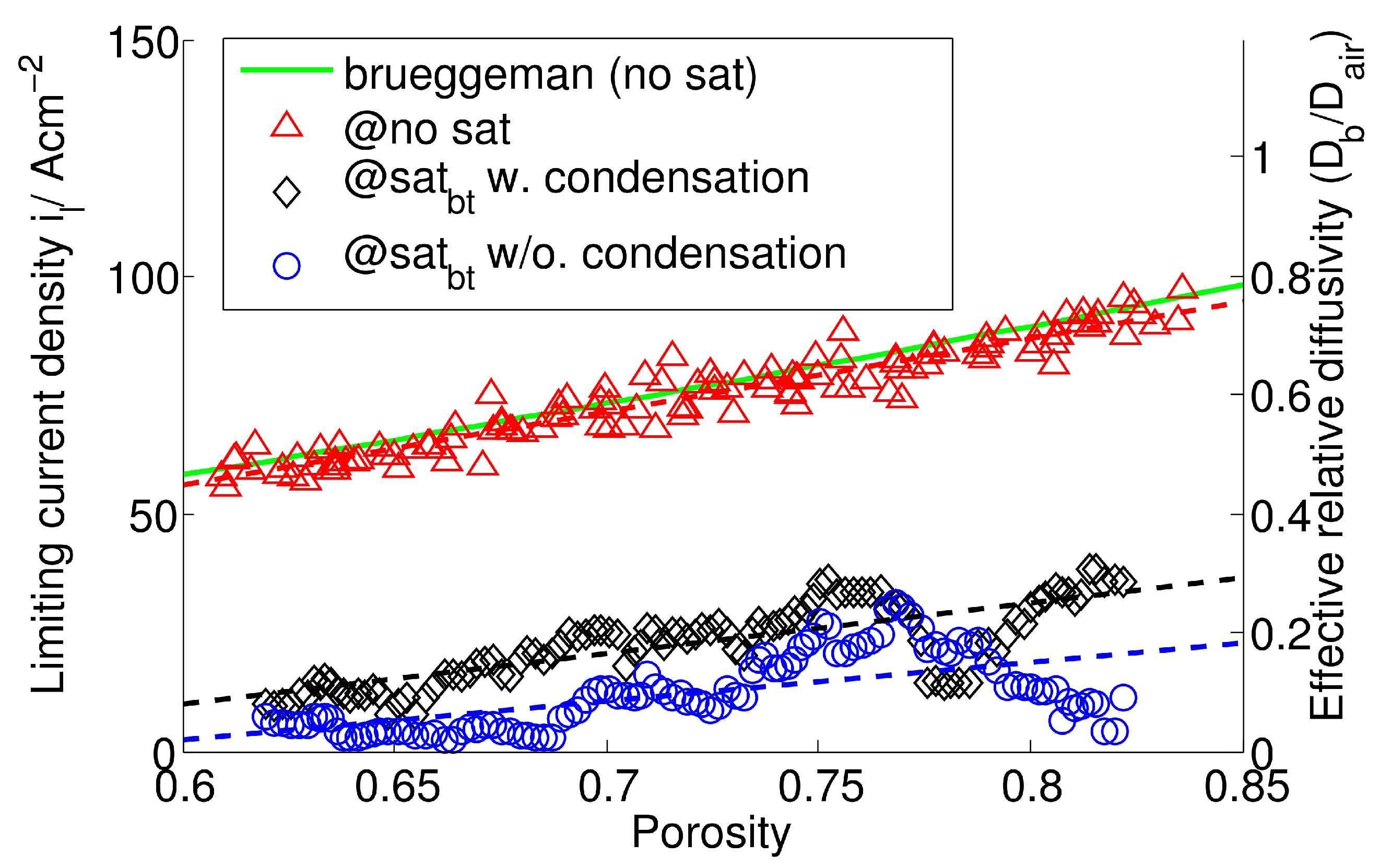
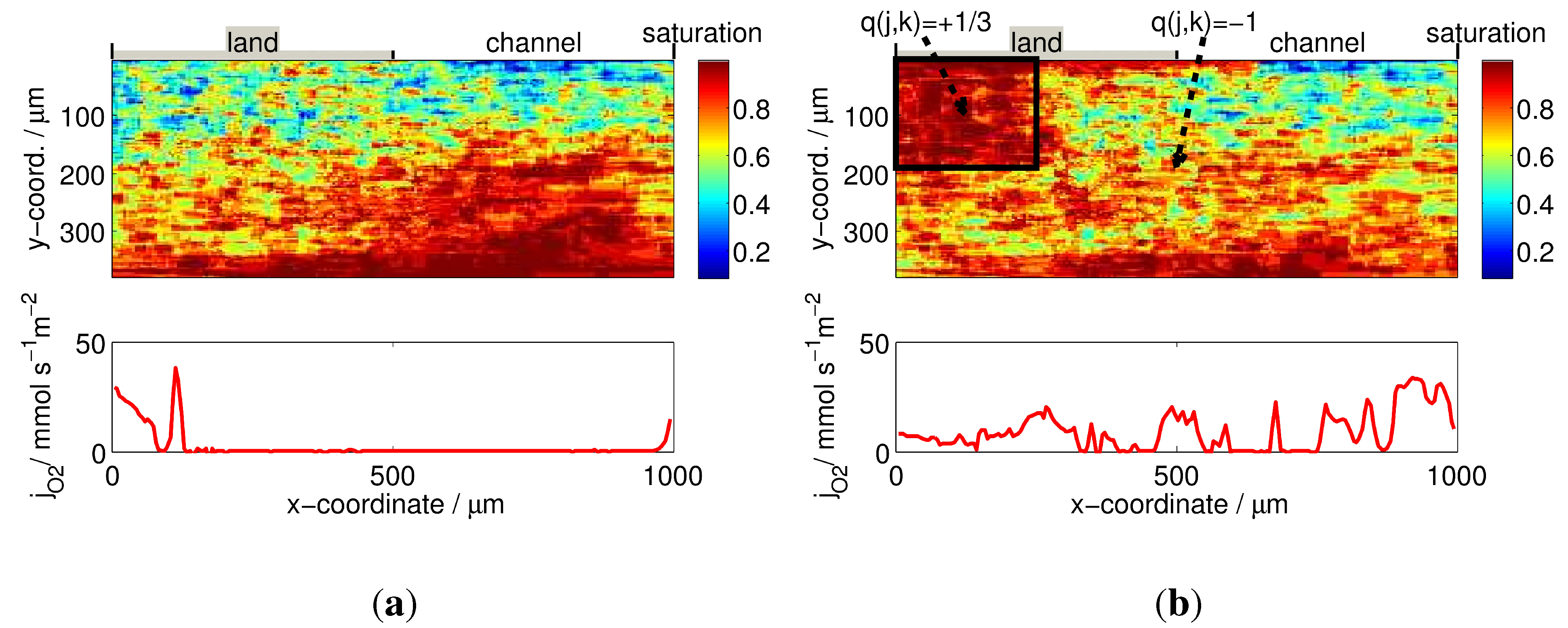
4. Conclusions
Acknowledgments
Conflicts of Interest
Symbols:
| β | object orientation in x/y plane |
| γ | surface tension of liquid |
| ϵ | porosity |
| Θ | contact angle |
| μ | mean value |
| ν | object orientation in x/z plane |
| σ | path orientation |
concentration difference | |
| b | object width |
| h | GDL height |
limiting current density | |
oxygen flux over boundary | |
| l | object length |
| n | number of electrons transferred during reaction |
| p | pressure |
capillary pressure | |
minimum path pressure at a location | |
minimum drainage pressure at location | |
evaporation/condensation sink/source term | |
| r | meniscus radius |
pore radius | |
| s | saturation |
standard deviation | |
bulk oxygen diffusion coefficient according to Bruggemann | |
oxygen diffusion coefficient in an object | |
oxygen diffusion coefficient in air | |
| F | faraday constant |
threshold values | |
| T | temperature |
unstable meniscus |
References
- Vengatesan, S.; Fowler, M.W.; Yuan, X.Z.; Wang, H. Diagnosis of MEA degradation under accelerated relative humidity cycling. J. Power Sources 2011, 196, 5045–5052. [Google Scholar] [CrossRef]
- Wu, J.; Yuan, X.Z.; Martin, J.J.; Wang, H.; Zhang, J.; Shen, J.; Wu, S.; Mérida, W. A review of PEM fuel cell durability: Degradation mechanisms and mitigation strategies. J. Power Sources 2008, 184, 104–119. [Google Scholar] [CrossRef]
- Borup, R.; Meyers, J.; Pivovar, B.; Kim, Y.S.; Mukundan, R.; Garland, N.; Myers, D.; Wilson, M.; Garzon, F.; Wood, D. Scientific aspects of polymer electrolyte fuel cell durability and degradation. Chem. Rev. 2007, 107, 3904–3951. [Google Scholar] [CrossRef] [PubMed]
- Seidenberger, K.; Wilhelm, F.; Schmitt, T.; Lehnert, W.; Scholta, J. Estimation of water distribution and degradation mechanisms in polymer electrolyte membrane fuel cell gas diffusion layers using a 3D Monte Carlo model. J. Power Sources 2011, 196, 5317–5324. [Google Scholar] [CrossRef]
- Tsai, J.C.; Lin, C.K. Effect of PTFE content in gas diffusion layer based on Nafion®/PTFE membrane for low humidity proton exchange membrane fuel cell. J. Taiwan Inst. Chem. Eng. 2011, 42, 945–951. [Google Scholar] [CrossRef]
- Park, S.; Popov, B.N. Effect of a GDL based on carbon paper or carbon cloth on PEM fuel cell performance. Fuel 2011, 90, 436–440. [Google Scholar] [CrossRef]
- Park, J.; Li, X. Multi-phase micro-scale flow simulation in the electrodes of a PEM fuel cell by lattice Boltzmann method. J. Power Sources 2008, 178, 248–257. [Google Scholar] [CrossRef]
- Lin, G.Y.; van Nguyen, T. Effect of thickness and hydrophobic polymer content of the gas diffusion layer on electrode flooding level in a PEMFC. J. Electrochem. Soc. 2005, 152, A1942–A1948. [Google Scholar] [CrossRef]
- Park, G.G.; Sohn, Y.J.; Yang, T.H.; Yoon, Y.G.; Lee, W.Y.; Kim, C.S. Effect of PTFE contents in the gas diffusion media on the performance of PEMFC. J. Power Sources 2004, 131, 182–187. [Google Scholar] [CrossRef]
- Alink, R.; Gerteisen, D.; Mérida, W. Investigating the water transport in porous media for PEMFCs by liquid water visualization in ESEM. Fuel Cells 2011, 11, 481–488. [Google Scholar] [CrossRef]
- Gerteisen, D.; Heilmann, T.; Ziegler, C. Enhancing liquid water transport by laser perforation of a GDL in a PEM fuel cell. J. Power Sources 2008, 177, 348–354. [Google Scholar] [CrossRef]
- Gerteisen, D.; Sadeler, C. Stability and performance improvement of a polymer electrolyte membrane fuel cell stack by laser perforation of gas diffusion layers. J. Power Sources 2010, 195, 5252–5257. [Google Scholar] [CrossRef]
- Manahan, M.P.; Hatzell, M.C.; Kumbur, E.C.; Mench, M.M. Laser perforated fuel cell diffusion media. Part I: Related changes in performance and water content. J. Power Sources 2011, 196, 5573–5582. [Google Scholar] [CrossRef]
- Manahan, M.; Mench, M. Increased performance of PEFCs with engineered mass-transport pathways. ECS Trans. 2011, 41, 569–581. [Google Scholar]
- Markötter, H.; Manke, I.; Krüger, P.; Arlt, T.; Haussmann, J.; Klages, M.; Riesemeier, H.; Hartnig, C.; Scholta, J.; Banhart, J. Investigation of 3D water transport paths in gas diffusion layers by combined in-situ synchrotron X-ray radiography and tomography. Electrochem. Commun. 2011, 13, 1001–1004. [Google Scholar] [CrossRef]
- Alink, R.; Haussmann, J.; Markötter, H.; Schwager, M.; Manke, I.; Gerteisen, D. The influence of porous transport layer modifications on the water management in polymer electrolyte membrane fuel cells. J. Power Sources 2013, 233, 358–368. [Google Scholar] [CrossRef]
- Gostick, J.T.; Ioannidis, M.A.; Fowler, M.W.; Pritzker, M.D. Pore network modeling of fibrous gas diffusion layers for polymer electrolyte membrane fuel cells. J. Power Sources 2007, 173, 277–290. [Google Scholar] [CrossRef]
- Ji, Y.; Luo, G.; Wang, C.Y. Pore-level liquid water transport through composite diffusion media of PEMFC. J. Electrochem. Soc. 2010, 157, B1753–B1761. [Google Scholar] [CrossRef]
- Luo, G.; Ji, Y.; Wang, C.Y.; Sinha, P.K. Modeling liquid water transport in gas diffusion layers by topologically equivalent pore network. Electrochim. Acta 2010, 55, 5332–5341. [Google Scholar] [CrossRef]
- Markicevic, B.; Djilali, N. Analysis of liquid water transport in fuel cell gas diffusion media using two-mobile phase pore network simulations. J. Power Sources 2011, 196, 2725–2734. [Google Scholar] [CrossRef]
- Nam, J.H.; Kaviany, M. Effective diffusivity and water-saturation distribution in single- and two-layer PEMFC diffusion medium. Int. J. Heat Mass Transf. 2003, 46, 4595–4611. [Google Scholar] [CrossRef]
- Sinha, P.K.; Wang, C.Y. Pore-network modeling of liquid water transport in gas diffusion layer of a polymer electrolyte fuel cell. Electrochim. Acta 2007, 52, 7936–7945. [Google Scholar] [CrossRef]
- Zhou, P.; Wu, C.W. Liquid water transport mechanism in the gas diffusion layer. J. Power Sources 2010, 195, 1408–1415. [Google Scholar] [CrossRef]
- Litster, S.; Sinton, D.; Djilali, N. Ex situ visualization of liquid water transport in PEM fuel cell gas diffusion layers. J. Power Sources 2006, 154, 95–105. [Google Scholar] [CrossRef]
- Thiedmann, R.; Manke, I.; Lehnert, W.; Schmidt, V. Random geometric graphs for modelling the pore space of fibre-based materials. J. Mater. Sci. 2011, 46, 7745–7759. [Google Scholar] [CrossRef]
- Wu, R.; Zhu, X.; Liao, Q.; Wang, H.; Ding, Y.D.; Li, J.; Ye, D.D. Determination of oxygen effective diffusivity in porous gas diffusion layer using a three-dimensional pore network model. Electrochim. Acta 2010, 55, 7394–7403. [Google Scholar] [CrossRef]
- Dong, H.; Blunt, M.J. Pore-network extraction from micro-computerized-tomography images. Phys. Rev. E 2009, 80, 036307:1–036307:11. [Google Scholar] [CrossRef] [PubMed]
- Gaiselmann, G.; Froning, D.; Tötzke, C.; Quick, C.; Manke, I.; Lehnert, W.; Schmidt, V. Stochastic 3D modeling of non-woven materials with wet-proofing agent. Int. J. Hydrog. Energy 2013, 38, 8448–8460. [Google Scholar] [CrossRef]
- Becker, J.; Wieser, C.; Fell, S.; Steiner, K. A multi-scale approach to material modeling of fuel cell diffusion media. Int. J. Heat Mass Transf. 2011, 54, 1360–1368. [Google Scholar] [CrossRef]
- James, J.P.; Choi, H.W.; Pharoah, J.G. X-ray computed tomography reconstruction and analysis of polymer electrolyte membrane fuel cell porous transport layers. Int. J. Hydrog. Energy 2012, 37, 18216–18230. [Google Scholar] [CrossRef]
- Bevers, D.; Rogers, R.; von Bradke, M. Examination of the influence of PTFE coating on the properties of carbon paper in polymer electrolyte fuel cells. J. Power Sources 1996, 63, 193–201. [Google Scholar] [CrossRef]
- Berning, T.; Odgaard, M.; Kaer, S.K. Percolation theory and network modeling applications in soil physics. J. Power Sources 2011, 196, 6305–6317. [Google Scholar] [CrossRef]
- Manke, I.; Hartnig, Ch.; Grunerbel, M.; Lehnert, W.; Kardjilov, N.; Haibel, A.; Hilger, A.; Banhart, J.; Riesemeier, H. Investigation of water evolution and transport in fuel cells with high resolution synchrotron X-ray radiography. Appl. Phys. Lett. 2007, 90, 174105:1–174105:3. [Google Scholar] [CrossRef]
- Fluckiger, R.; Marone, F.; Stampanoni, M.; Wokaun, A.; Buchi, F.N. Investigation of liquid water in gas diffusion layers of polymer electrolyte fuel cells using X-ray tomographic microscopy. Electrochim. Acta 2011, 56, 2254–2262. [Google Scholar] [CrossRef]
- Kim, J.; Je, J.; Kim, T.; Kaviany, M.; Son, S.Y.; Kim, M. Breakthrough/drainage pressures and X-ray water visualization in gas diffusion layer of PEMFC. Curr. Appl. Phys. 2012, 12, 105–108. [Google Scholar] [CrossRef]
- Utaka, Y.; Hirose, I.; Tasaki, Y. Characteristics of oxygen diffusivity and water distribution by X-ray radiography in microporous media in alternate porous layers of different wettability for moisture control in gas diffusion layer of PEFC. Int. J. Hydrog. Energy 2011, 36, 9128–9138. [Google Scholar] [CrossRef]
- Gostick, J.T.; Ioannidis, M.A.; Fowler, M.W.; Pritzker, M.D. Wettability and capillary behavior of fibrous gas diffusion media for polymer electrolyte membrane fuel cells. J. Power Sources 2009, 194, 433–444. [Google Scholar] [CrossRef]
- Wood, D.L., III; Rulison, C.; Borup, R.L. Surface properties of PEMFC gas diffusion layers. J. Electrochem. Soc. 2010, 157, B195–B206. [Google Scholar] [CrossRef]
- Bird, R.B.; Steward, W.E.; Lightfood, E.N. Transport Phenomena; John Wiley and Sons, Inc.: New York, NY, USA, 2002. [Google Scholar]
- Shou, D.; Fan, J.; Ding, F. Effective diffusivity of gas diffusion layer in proton exchange membrane fuel cells. J. Power Sources 2013, 225, 179–186. [Google Scholar] [CrossRef]
- Flückiger, R.; Freunberger, S.A.; Kramer, D.; Wokaun, A.; Scherer, G.G.; Büchi, F.N. Anisotropic, effective diffusivity of porous gas diffusion layer materials for PEFC. Electrochim. Acta 2008, 54, 551–559. [Google Scholar] [CrossRef]
© 2013 by the authors; licensee MDPI, Basel, Switzerland. This article is an open access article distributed under the terms and conditions of the Creative Commons Attribution license (http://creativecommons.org/licenses/by/3.0/).
Share and Cite
Alink, R.; Gerteisen, D. Modeling the Liquid Water Transport in the Gas Diffusion Layer for Polymer Electrolyte Membrane Fuel Cells Using a Water Path Network. Energies 2013, 6, 4508-4530. https://doi.org/10.3390/en6094508
Alink R, Gerteisen D. Modeling the Liquid Water Transport in the Gas Diffusion Layer for Polymer Electrolyte Membrane Fuel Cells Using a Water Path Network. Energies. 2013; 6(9):4508-4530. https://doi.org/10.3390/en6094508
Chicago/Turabian StyleAlink, Robert, and Dietmar Gerteisen. 2013. "Modeling the Liquid Water Transport in the Gas Diffusion Layer for Polymer Electrolyte Membrane Fuel Cells Using a Water Path Network" Energies 6, no. 9: 4508-4530. https://doi.org/10.3390/en6094508




